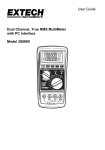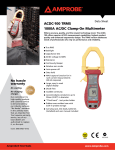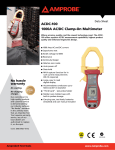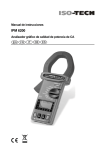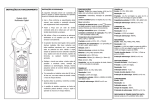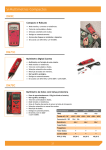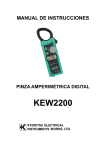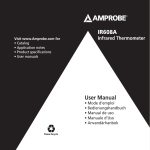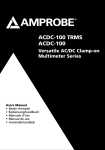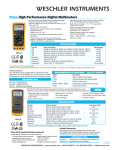Download Amprobe ACDC-100 Specifications
Transcript
ACDC-100 TRMS ACDC-100 Versatile AC/DC Clamp-on Multimeter Series 99 Washington Street Melrose, MA 02176 Phone 781-665-1400 Toll Free 1-800-517-8431 Visit us at www.TestEquipmentDepot.com Users Manual Versatile AC/DC Clamp-on Multimeter Series Users Manual ACDC100_Rev002 © 2010 Amprobe Test Tools. All rights reserved. 1 English ACDC-100 TRMS ACDC-100 Limited Warranty and Limitation of Liability Your Amprobe product will be free from defects in material and workmanship for 1 year from the date of purchase. This warranty does not cover fuses, disposable batteries or damage from accident, neglect, misuse, alteration, contamination, or abnormal conditions of operation or handling. Resellers are not authorized to extend any other warranty on Amprobe’s behalf. To obtain service during the warranty period, return the product with proof of purchase to an authorized Amprobe Test Tools Service Center or to an Amprobe dealer or distributor. See Repair Section for details. This warranty is your only remedy. All other warranties - whether express, implied or stautory - including implied warranties of fitness for a particular purpose or merchantability, are hereby disclaimed. Manufacturer shall not be liable for any special, indirect, incidental or consequential damages or losses, arising from any cause or theory. Since some states or countries do not allow the exclusion or limitation of an implied warranty or of incidental or consequential damages, this limitation of liability may not apply to you. Repair All test tools returned for warranty or non-warranty repair or for calibration should be accompanied by the following: your name, company’s name, address, telephone number, and proof of purchase. Additionally, please include a brief description of the problem or the service requested and include the test leads with the meter. Non-warranty repair or replacement charges should be remitted in the form of a check, a money order, credit card with expiration date, or a purchase order made payable to Amprobe ® Test Tools. In-Warranty Repairs and Replacement – All Countries Please read the warranty statement and check your battery before requesting repair. During the warranty period any defective test tool can be returned to your Amprobe ® Test Tools distributor for an exchange for the same or like product. Please check the “Where to Buy” section on www.amprobe.com for a list of distributors near you. Additionally, in the United States and Canada In-Warranty repair and replacement units can also be sent to a Amprobe ® Test Tools Service Center (see address below). Non-Warranty Repairs and Replacement – US and Canada Non-warranty repairs in the United States and Canada should be sent to a Amprobe ® Test Tools Service Center. Call Amprobe ® Test Tools or inquire at your point of purchase for current repair and replacement rates. In USA Amprobe Test Tools Everett, WA 98203 Tel: 877-AMPROBE (267-7623) In Canada Amprobe Test Tools Mississauga, ON L4Z 1X9 Tel: 905-890-7600 Non-Warranty Repairs and Replacement – Europe European non-warranty units can be replaced by your Amprobe ® Test Tools distributor for a nominal charge. Please check the “Where to Buy” section on www.amprobe.com for a list of distributors near you. European Correspondence Address* Amprobe ® Test Tools Europe In den Engematten 14 79286 Glottertal, Germany Tel.: +49 (0) 7684 8009 - 0 *(Correspondence only – no repair or replacement available from this address. European customers please contact your distributor.) 2 ➊Hall-effect Clamp Jaw for AC & DC current electric field pick up ➋Hand/Finger Barrier to indicate the limits of safe access of the meter during measurement ➌Push-buttons for special functions & features ➍Input Jack for all functions EXCEPT noninvasive ACA & DCA current functions ➎Common (Ground reference) Input Jack for all functions EXCEPT non-invasive ACA & DCA current functions ➏Slide-switch Selector to turn the power ON/OFF and Select a function ➐3-3/4 digits 4000 ➑Jaw trigger for ➒Jaw center Indicators, counts LCD display opening the clamp jaw at where best ACA & DCA accuracy is specified 3 ACDC-100 TRMS / ACDC-100 Versatile AC/DC Clamp-on Multimeter Series Contents Symbols..............................................................................................................................................5 Safety Information............................................................................................................................5 Unpacking and Contents..................................................................................................................6 Introduction.......................................................................................................................................6 Features ............................................................................................................................................6 Alignment marks ........................................................................................................................6 MAX � / HOLD � ......................................................................................................................6 HOLD ...........................................................................................................................................7 MAX . ...........................................................................................................................................7 r Relative Zero mode ................................................................................................................7 SELECT / Backlight ( �) ..............................................................................................................7 Manual or Auto-ranging ............................................................................................................7 Auto Power Off function ...........................................................................................................7 Operation .........................................................................................................................................7 DC Voltage ..................................................................................................................................7 AC Voltage ..................................................................................................................................7 AC Current ..................................................................................................................................8 DC Current ..................................................................................................................................8 Resistance ....................................................................................................................................8 Continuity ...................................................................................................................................8 Diodes . ........................................................................................................................................8 Capacitance .................................................................................................................................9 Maintenance and Repair .................................................................................................................9 Battery Replacement ..................................................................................................................9 Specifications...................................................................................................................................10 General Specifications...............................................................................................................10 Electrical ...................................................................................................................................11 4 Symbols � Battery � Refer to the manual � Double insulated � Dangerous Voltage � Direct Current � Earth Ground � Alternating Current � Audible tone � Conforms to relevant Australian standards. � Complies with EU directives � Do not dispose of this product as unsorted municipal waste. � Underwriters Laboratories. [Note: Canadian and US.] � Application around and removal from hazardous live conductors is permitted Safety Information • The ACDC-100 Series Digital Clampmeters conform to EN61010-1:2001; EN61010- 2032:2002; CAT III 600 V, class 2 and pollution deg.2 • This instrument is EN61010-1 certified for Installation Category III (600V). It is recommended for use in distribution level and fixed installations, as well as lesser installations, and not for primary supply lines, overhead lines and cable systems. • Do not exceed the maximum overload limits per function (see specifications) nor the limits marked on the instrument itself. Never apply more than 600 Vdc/600 V ac rms between the test lead and earth ground. � Warnings and Precautions • Before and after hazardous voltage measurements, test the voltage function on a known source such as line voltage to determine proper meter functioning. • Disconnect the test leads from the test points before changing meter functions. • Inspect the Clampmeter, test leads and accessories before every use. Do not use any damaged part. • Never ground yourself when taking measurements. Do not touch exposed circuit elements or test probe tips. • Do not operate the instrument in an explosive atmosphere. • To reduce the risk of fire or electric shock, do not expose this product to rain or moisture. • The meter is intended only for indoor use. To avoid electrical shock hazard, observe the proper safety precautions when working with voltages above 60 VDC or 30 VAC rms. These voltage levels pose a potential shock hazard to the user. 5 • Before and after hazardous voltage measurements, test the voltage function on a known source such as line voltage to determine proper meter functioning. • Keep your hands/fingers behind the hand/finger barriers (of the meter and the test leads) that indicate the limits of safe access of the hand-held part during measurement. • Inspect test leads, connectors, and probes for damaged insulation or exposed metal before using the instrument. If any defects are found, replace them immediately. • This Clamp-on meter is designed to apply around or remove from uninsulated hazardous live conductors. Individual protective equipment must be used if hazardous live parts of the installation could be accessible. • Exercise extreme caution when: measuring voltage >20 V // current >10 mA // AC power line with inductive loads // AC power line during electrical storms // current, when the fuse blows in a circuit with open circuit voltage >1000 V // servicing CRT equipment. • Remove test leads before opening the case to change the battery. • Disconnect circuit power and discharge all high-voltage capacitors before testing resistance,continuity, diodes, or capacitance. • To avoid false readings, which could lead to possible electric shock or personal injury, replace the batteries as soon as the low battery indicator (�) appears. Unpacking and Contents Your shipping carton should include 1 ACDC-100 or ACDC-100 TRMS 1 Test lead set 2 1.5V AAA Battery (Installed) 1 Users Manual 1 Carrying Case If any of the items are damaged or missing, immediately return the complete package to the place of purchase for an exchange. Introduction The ACDC-100 and ACDC-100 TRMS Clamp-On meters are 1000 Amp / 600 V clamp meters with 50 mm jaw opening for industrial applications. The features include large conductor size and in-rush current measurement along with AC / DC voltage, AC / DC current, Resistance, Continuity and Diode Tests. Features Alignment marks (see Fig. 1) Place conductor within the jaws at the intersection of the indicated marks as close as possible to maximize the accuracy of the reading. MAX � / HOLD � The HOLD feature freezes the display when the � button is pressed. The MAX feature compares and displays the measured maximum value as fast as 30ms with auto-ranging capability. 6 HOLD Press the HOLD button momentarily toggles to hold mode for all of the functions. To release the HOLD feature momentarily press the HOLD button. MAX Press the HOLD button for 1 second or more activates the MAX HOLD feature for the VDC, VAC and ACA functions. To release the MAX HOLD feature press the HOLD button for 1 second or more. r Relative Zero mode Relative Zero mode allows the user to offset the subsequent meter measurements with the displayed reading as the reference value. The display will now show readings relative to the stored reference value. That is, display = reading - stored value. Pressing the button momentarily toggles to relative mode. SELECT / Backlight ( �) Press Backlight button more than 1 second, enable/disable Backlight. Press the SELECT / Backlight button to step through the manually selected A� and Ω functions. A� → A� and Ω → � → � → � Manual or Auto-ranging Press the RANGE button momentarily to select manual-ranging mode. The LCD symbol turns off. Press the button momentarily again to step through the Ranges. Press and hold the RANGE button for more than 1 second to resume auto-ranging. Auto Power Off function The clamp meter powers down automatically after approximately 30 minutes of inactivity. To turn it back on, move the function selector switch to OFF and back to a measuring function. To disable Auto Power Off, press and hold the HOLD button while moving the slide switch to the desired function from OFF. Operation DC Voltage (see Fig. 1) 1. Set the Function Switch to V�. 2. Connect the test leads: Red to +, Black to COM. 3. Connect the test probes to the circuit test points. 4. Read the display, and if necessary, correct any overload (0L) conditions. AC Voltage (see Fig. 1) 1. Set the Function Switch to V�. 2. Connect the test leads: Red to +, Black to COM. 3. Connect the test probes to the circuit test points. 4. Read the display, and if necessary, correct any overload (0L) conditions. 7 AC Current (see Fig. 2) 1. Set the Function Switch to A� position. 2. Select AC current using the SELECT button. 3. Open spring-loaded clamp by pressing the lever on left side of meter. 4. Position clamp around one wire or conductor and release the clamp lever. Make sure that the clamp is entirely closed. The clamp must be positioned around only one conductor. If it is placed around two or more current carrying conductors, the reading is FALSE. 5. Read the displayed value, and if necessary, correct any overload (0L) conditions. DC Current (see Fig. 2) 1. Set the Function Switch to A� position. 2. Select DC current using the SELECT button. 3. Open spring-loaded clamp by pressing the lever on left side of meter. 4. Position clamp around one wire or conductor and release the clamp lever. Make sure that the clamp is entirely closed. The clamp must be positioned around only one conductor. If it is placed around two or more current carrying conductors, the reading is FALSE. 5. Read the displayed value, and if necessary, correct any overload (0L) conditions. CAUTION Using the Resistance, Continuity, Diode or Capacitance functions on a live circuit will produce false results and may damage the instrument. In many cases the suspected component must be disconnected from the circuit to obtain an accurate measurement reading. Resistance (see Fig. 3) 1. Set the Function Switch to Ω. 2. Connect the test leads: Red to +, Black to COM. 3. Turn off power to the circuit being measured. 4. Discharge any capacitors that may influence the reading. 5. Connect the test probes across the resistance. 6. Read the display. If 0L appears on the highest range, the resistance is too large to be measured or the circuit is an open circuit. Continuity (see Fig. 3) 1. Set the Function Switch to Ω and press the SELECT button until � is displayed. 2. Connect the test leads: Red to +, Black to COM. 3. Turn off power to the circuit being measured. 4. Discharge any capacitors that may influence the reading. 5. Connect the test probes across the resistance or the two points of test. 6. Listen for the tone that indicates continuity (>10 Ω and < 120 Ω). Diodes (see Fig. 3) 1. Set the Function Switch to Ω and press the SELECT button until � is displayed. 2. Connect the test leads: Red to +, Black to COM. 8 3. Turn off power to the circuit being measured. 4. Free at least one end of the diode from the circuit. 5. Connect the test probes across the diode noting polarity. 6. Read the display. A good diode has a forward voltage drop of about 0.6 V. An open or reverse biased diode will read .0L. Capacitance (see Fig. 3) 1. Set the Function Switch to Ω and press the SELECT button until � is displayed. 2. Connect the test leads: Red to +, Black to COM. 3. Turn off power to the circuit being measured. 4. Discharge the capacitor using a 100 kΩ resistor. 5. Free at least one end of the capacitor from the circuit. 6. Connect the test probes across the capacitor. 7. Read the display. 8. Relative zero mode can be used to zero out the parasitic capacitance of the leads and the internal protection circuitry of the meter when measuring low capacitance in the order of Pico Farad (pF). Maintenance and Repair If there appears to be a malfunction during the operation of the meter, the following steps should be performed in order to isolate the cause of the problem: 1. Check the battery. 2. Review the operating instructions for possible mistakes in operating procedure. 3. Inspect and test the test leads for a broken or intermittent connection. Except for the replacement of the battery or test probes, repair of the multimeter should be performed only by a Factory Authorized Service Center or by other qualified instrument service personnel. The front panel and case can be cleaned with a mild solution of detergent and water. Apply sparingly with a soft cloth and allow to dry completely before using. Do not use aromatic hydrocarbons or chlorinated solvents for cleaning. Battery Replacement (see Fig. 4) � Warning To prevent electrical shock or meter damage, disconnect the meter’s test leads from any circuit and the meter, then turn the meter off before removing the battery cover. Battery replacement should be performed in a clean environment and with appropriate care taken to avoid contaminating the meter’s interior components. 1. Remove the screw and lift the battery cover. 2. Replace the batteries with the same type (1.5V AAA). Note polarity guide below the battery. 3. Replace the battery cover and screw. 9 Specifications General Specifications Display: 3-3/4 digits 4000 counts LCD display Update Rate: 3 per second nominal Polarity: Automatic Power Supply: standard 1.5V AAA Size (NEDA 24G or IEC R03) battery x Power Consumption: typical 11 mA for ACA/DCA and 2.9 mA for other functions APO Timing: idle for 30 minutes APO Consumption: typical 10µA for ACDC- 100 and 90µA for ACDC- 100 TRMS Low battery: below approx. 2.4V Environment:Indoor operation, below 2000 m Temperature / Humidity: Operating: 0°C to 40°C (14°F to 122 °F) Relative humidity : < 80% RH @ 31°C decreasing linearly to 50% RH at 40°C Storage: -20°C to 60°C (-4°F to 122 °F) / < 80% RH Temperature Coefficient : 0. 5 x (specified accuracy)/ °C @ (0°C to 18°C or 28°C to 40°C) Sensing : Average sensing for ACDC- 100; True RMS for ACDC- 100 TRMS Clamp-on jaw: DC 1000A or AC 800A rms continuous + & COM terminals (all functions) : 600VDC/VAC rms Jaw opening: 50mm max Dimension : 227 x 78 x 40mm (8.9 x 3.1 x 1.6 in.) Weight : 290 gm ( 0.6 lb) Safety LVD: Meets EN60101-1:2001; EN61010-2-032(2002), Category III- 600 Volts ac & dc; pollution degree : 2; class 2 �EMC: This product complies with requirements of the following European Community Directives: 89/336/EEC (Electromagnetic Compatibility) and 73/23/EEC (Low Voltage) as amended by 93/68/EEC (CE Marking). However, electrical noise or intense electromagnetic fields in the vicinity of the equipment may disturb the measurement circuit. Measuring instruments will also respond to unwanted signals that may be present within the measurement circuit. Users should exercise care and take appropriate precautions to avoid misleading results when making measurements in the presence of electronic interference. 10 Electrical (23 °C ± 5 °C) < 75% RH DC Voltage RANGE 400.0 mV 4.000V, 40.00V, 400.0V 600V Accuracy ± (0.3% + 3dgts) ± (0.5% + 3dgts) ± (1.0% + 4dgts) Resolution : 0.1 mV on 400 mV range NMRR : >50dB @ 50/60Hz CMRR : >20dB @ DC, 50/60Hz, Rs=1kΩ Input Impedance : 10MΩ, 30pF nominal (1000MΩ for 400.0mV range) Max input : 600VDC/VAC rms AC Voltage RANGE 400.0mV 1) 4.000V, 40.00V, 400.0V 4.000V, 40.00V, 400.0V 600V Resolution: 0.1 mV on 400 mV range Frequency 50Hz to 500Hz 50Hz to 60Hz 60Hz to 500Hz 50Hz to 500Hz Accuracy ± (4.0% + 4dgts) ± (1.0% + 4dgts) ± (1.5% + 4dgts) ± (2.0% + 4dgts) CMRR : >60db @ DC to 60Hz, Rs= 1kΩ Input impedance: 10MΩ, 30pf nominal Crest factor (ACDC-100 TRMS): < 1.6: at full scale; < 3.2: at half scale Max input: 600VDC/VAC rms 1) Selection by Range button manually, and is specified from AC 40mV (AC 60mV for ACDC100 TRMS) and up Resistance RANGE 400.0Ω 4.000kΩ, 40.00kΩ, 400.0kΩ 4.000MΩ 40.00MΩ Accuracy ± (0.8% + 6dgts) ± (0.6% + 4dgts) ± (1.0% + 4dgts) ± (2.0% + 4dgts) Resolution: 0.1 Ω on 400 Ω range Open Circuit Voltage : 0.4VDC typical Continuity Tester Open Circuit Voltage: 0.4Vdc typical Range: 400.0Ω Accuracy: ± (1.5% + 6dgts) Audible threshold: between 10Ω and 120Ω. Diode Tester Open Circuit Voltage < 1.6 Vdc Test Current (Typical) 0.4mA 11 Capacitance RANGE 1) Accuracy 2) 3) 500.0 nf, 5.000 µf, 50.00 µf, 500.0 µf, 3000 µf ± (3.5% + 6dgts) Resolution: 0.1 nf on 500.0 nf range 1) Additional 50.00nf range accuracy is not specified 2) Accuracies with film capacitor or better 3) Specified with battery voltage above 2.8V (approximately half full battery). Accuracy decreases gradually to 12% at low battery warning voltage of approximately 2.4V DC Current (Clamp-On) Accuracy 1) 2) RANGE 0.0A to 400.0A ± (1.5% + 4dgts) 400A to 800A ± (1.5% + 4dgts) 800A to 900A ± (2.0% + 4dgts) 900A to 1000A ± (5.0% + 30dgts) Max current: 1000A continuous Resolution: 0.1 A on 400 A range 1) Induced error from adjacent current-carrying conductor: < 0.01A/A 2) Zero mode must be applied to zero the unit before measurement to ensure accuracy. ACA Current (Clamp-on) RANGE Frequency Accuracy 1) 2) 400.0A 5Hz to 40Hz ± (2.0% + 5dgts) 3) 400.0A 40Hz to 200Hz ± (1.5% + 5dgts) < 50A 4) 200Hz to 400Hz ± (1.5% + 5dgts) < 50A 4) 400Hz to 1kHz ± (2.0% + 5dgts) 400A to 600A 5Hz to 40Hz ± (2.0% + 5dgts) 3) 400A to 600A 40Hz to 100Hz ± (1.5% + 4dgts) 600A to 800A 5Hz to 60Hz ± (5.0% + 30dgts) Max current: 800A rms continuous Resolution: 0.1 A on 400 A range 1) Induced error from adjacent current-carrying conductor: < 0.01A/A 2) Crest Factor (ACDC-100 TRMS): < 1.6 : at full scale; < 3.2 : at half scale 3) ± (4.0% + 5dgts) for ACDC- 100 TRMS 4) Accuracy is specified at <50A in this frequency bandwidth due to limited calibrator output capability for testing 12 Figure 1. — DC Voltage and AC Voltage functions 13 Figure 2. — ACA & DCA Current clamp-on function 14 Figure 3. — Resistance, Continuity, Capacitance and Diode functions Figure 4. — Battery replacement 15
















